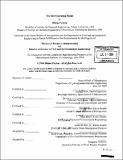The Dell operating model
Author(s)
Paxton, Blaine Kermit
DownloadFull printable version (22.38Mb)
Other Contributors
Leaders for Manufacturing Program.
Advisor
George Roth and Deborah Nightingale.
Terms of use
Metadata
Show full item recordAbstract
Dell, Inc. is well known for its dramatic and continually improving operational performance in terms of unit cost, inventory level, production capacity, and labor efficiency. However, in late 2002, several members of Dell's Americas operations group realized that they did not fully understand what was driving this operational excellence. Therefore, they decided to sponsor an MIT Leaders for Manufacturing internship project to find out. The goal of this project was to "identify and document the essential beliefs, principles, and practices that have contributed to the operations success at Dell". The result of this endeavor is a model which describes four beliefs that are widely shared between members of Dell's operations organizations. These four beliefs (or cultural elements) are, in turn, supported by a set of specific management practices and programs. This model was developed using qualitative organizational research methods including conducting semi-structured interviews, holding focus groups, and gathering individual feedback on a draft version of the model for final validation. In this thesis, the "Dell Operating Model" is described, and each element of the model is shown to support Dell's critical business objectives. The model is then examined through the lenses of three organizational frameworks, and the limitations of these alternate frameworks are discussed. Finally, the applicability of the model to other companies is discussed, and new projects are proposed that will build on this research.
Description
Thesis (M.B.A.)--Massachusetts Institute of Technology, Sloan School of Management; and, (S.M.)--Massachusetts Institute of Technology, Dept. of Civil and Environmental Engineering; in conjunction with the Leaders for Manufacturing Program at MIT, 2004. Includes bibliographical references (p. 62-63).
Date issued
2004Department
Leaders for Manufacturing Program at MIT; Massachusetts Institute of Technology. Department of Civil and Environmental Engineering; Sloan School of ManagementPublisher
Massachusetts Institute of Technology
Keywords
Sloan School of Management., Civil and Environmental Engineering., Leaders for Manufacturing Program.